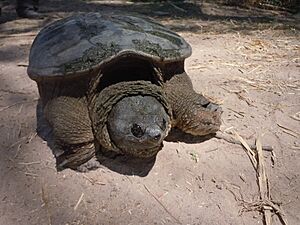Central American snapping turtle facts for kids
Quick facts for kids Central American snapping turtle |
|
|---|---|
 |
|
| Conservation status | |
| Scientific classification | |
| Genus: |
Chelydra
|
| Species: |
rossignonii
|
| Synonyms | |
|
|
The Central American snapping turtle (Chelydra rossignonii) is a special type of turtle. It is also known as the Mexican snapping turtle or the Yucatán snapping turtle. This turtle lives only in Central America and Mexico. It is part of the Chelydridae family, which includes other snapping turtles.
Contents
About This Turtle's Name
How It Became Its Own Species
For a long time, scientists thought the Central American snapping turtle was just a type of common snapping turtle. But then, they looked closely at their genes and the shape of their skulls. They found enough differences to decide it was its own unique species.
Why Is It Called Rossignonii?
The second part of the turtle's scientific name, rossignonii, honors a French coffee farmer named Jules Rossignon.
Are There Different Types?
No, there are no different types or subspecies of the Central American snapping turtle. It is just one distinct species.
What Does It Look Like?
The Central American snapping turtle has a big head and a long tail. Its snout is pointed, and its top shell, called a carapace, is rough. The carapace has three clear ridges and can be brown, olive, or even black. Its smaller bottom shell, called a plastron, can be cream, yellow, tan, or gray.
Sometimes, algae grows on its shell. This helps the turtle blend in with its surroundings, like a natural camouflage. Adult turtles have gray or black skin. Young turtles have cool white speckles on their skin. The skin near their neck also has long bumps called tubercles.
Where Does It Live?
You can find the Central American snapping turtle in Belize, Guatemala, Honduras, and Mexico. These turtles love living in slow-moving fresh water. Their favorite places are rivers, swamps, small streams (called tributaries), and wetlands. They prefer murky water with lots of plants and usually stay away from open, clear water.
How Does It Live?
The Central American snapping turtle lays eggs, which means it is oviparous. It is also a loner, meaning it mostly lives by itself. These turtles are nocturnal, so they are most active at night. They spend most of their time in the water and rarely come out onto land or sunbathe in open areas.
What Does It Eat?
This turtle is a clever hunter! It sits still underwater with its mouth open. It has four to six small feelers, called barbels, around its mouth. It also wiggles its tongue. These movements make the barbels and tongue look like small worms. This trick attracts prey closer. When an animal gets close enough, the turtle quickly snaps its mouth shut.
Scientists believe it is an omnivore, meaning it eats both plants and animals. It hunts for different foods like crabs, frogs, fish, and shrimp. It also eats some plant material.
Is It in Danger?
Sadly, the number of Central American snapping turtles has dropped by 30% in the last 30 years. They are threatened by two main things. First, their homes are being destroyed. Second, too many are being caught for food. Even though laws in Mexico and Guatemala protect them, these laws are not always followed.
To help these turtles, a special breeding program has been started. This program helps the turtles have babies in a safe environment. The goal is to increase their population and protect them for the future.


